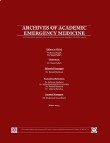Pattern of Neurological Disorders among Patients Evaluated in the Emergency Department; Cross–Sectional Study
Neurologic disorders are common reasons for emergency consultations. Most neurologic disorders seenin the emergency department (ED) are life-threatening and require urgent treatment. The goal of this study is to investi-gate the pattern of neurological disorders among patients evaluated in the ED.
This is a cross-sectional studyconducted in the ED of Mogadishu Somali Turkish Training and Research Hospital, from July 2021 to February 2022. Theclinical and epidemiological characteristics of adult patients with neurologic manifestations in the ED were evaluated.Age, gender, distribution of neurological disease manifestations, neurological examination findings, and neurologicaldiagnoses made by consultant neurologists were assessed.
During the study period, 321 patients were assessed(3.7% of all ED admissions). The majority of the patients in the study were above 50 years of age (62.6% male). Hyper-tension was the most common comorbidity among these patients with 122 (38%) cases, followed by diabetes mellituswith 65 (20.2%), and heart diseases with 26 (8.1%) cases. The main reasons for neurology consultations were alteredmental status with 141 (44%) cases, motor weakness with 102 (31.8%), seizures with 33 (10%), headache with 17 (5.3%),and vertigo with 9 (2.8%) cases. 196 (61%) had hemiplegia, 60 (18.7%) had consciousness impairment, and 38 (11.8%)had normal neurological examination. The most frequent neurological diagnoses were ischemic strokes with 125 (39%)cases, hemorrhagic strokes with 65 (20.2%), epileptic seizures with 28 (8.7%), and metabolic encephalopathies with 13(4%) cases. The median duration of the neurology consultations was 20 minutes. 251 (78%) of the patients were ad-mitted to the hospital, while 70 (22%) were discharged from the emergency department. After neurology consultation,the neurology department made the most admissions with 226 (90%) cases, while 25 (10%) were admitted by other de-partments. Of those admitted, 186 (74.2%) were admitted to the neurology ward, and 65 (25.8%) were admitted to theintensive care unit.
In our study, neurologic emergencies accounted for 3.7% of all emergency admissions.Stroke, epileptic seizures, cerebral venous thrombosis, encephalopathies, and acute spinal cord diseases were the mostcommon neurological disorders. The admission rate was very high following neurologic assessment by neurologists.
- حق عضویت دریافتی صرف حمایت از نشریات عضو و نگهداری، تکمیل و توسعه مگیران میشود.
- پرداخت حق اشتراک و دانلود مقالات اجازه بازنشر آن در سایر رسانههای چاپی و دیجیتال را به کاربر نمیدهد.


